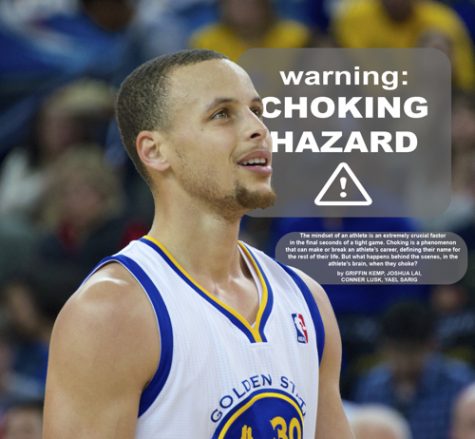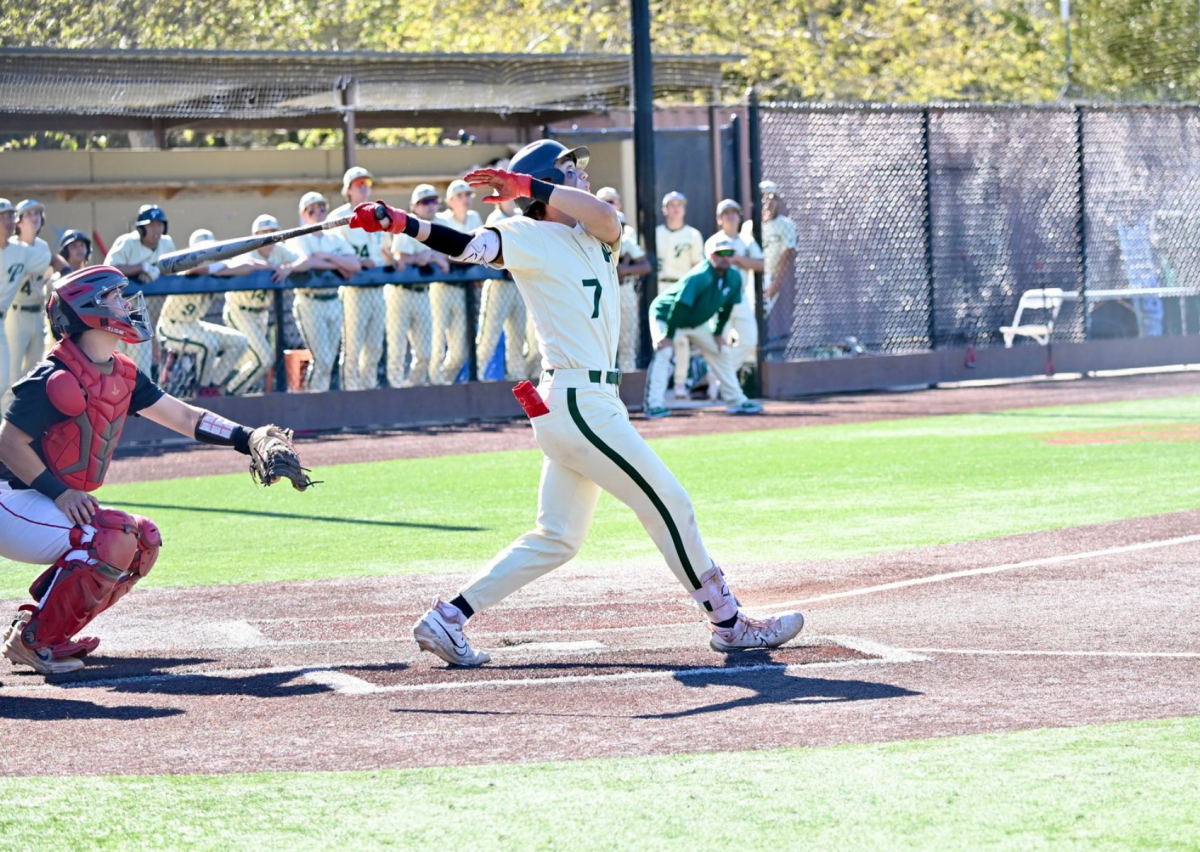Warning: Choking Hazard
The mindset of an athlete is an extremely crucial factor in the final seconds of a tight game. Choking is a phenomenon that can make or break an athlete’s career, defining their name for the rest of their life. But what happens behind the scenes, in the athlete’s brain, when they choke?
December 3, 2018

The red analog numbers tick down. 15 seconds. 14 seconds.
Coach is screaming in your ear – something about high-low, and run the clock out – but you barely hear him. Barely hear the raucous screaming of the fans, and barely feel the slight tremor shaking the wooden court as they jump up and down on the rickety metal bleachers.
Your team is down two. You size up the defender. He’s giving you space. You could easily cut to the post, maybe dish it out to your teammate, who’s been camped out on the three point line for god knows how long.
But this is your moment. Nine seconds. Eight seconds.
You cross him once. Then again. Now you’ve got room – more than enough. Five seconds.
You shoot. No one within 10 feet of you, clear look at the basket. It’s a shot you’ve taken – and made – thousands of times in your life. You hold your follow through. The arena holds its breath.
The buzzer sounds, angry and incessant, disrupting the seemingly frozen arena. It’s a buzzing fly around your head, but no matter how many times you swat at it it doesn’t seem to leave, echoing in your eardrums for seconds that seem like minutes that seem like hours.
Final score, 109 to 107.
You missed. Cost your team the win. Lost.
You didn’t just miss –
you choked.
What happened? chides your coach. You give him a half hearted excuse about getting in your own head, which is currently pulsating from the heartbeat that seems to have relocated itself to your temple.
But really, that shot was makeable – so what did happen?
Choking is a phenomenon that has existed in sports for as long as anyone can remember. The 73-9 Golden State Warriors infamously blew a 3-1 lead in the NBA finals, becoming the first ever team in the NBA Finals to do so. And before them, the Oklahoma City Thunder eerily blew the exact same lead against the Warriors in the Western Conference Finals. The Falcons blew a 28-3 lead. The Patriots lost in the Super Bowl after going 16-0 in the regular season. The Seahawks passed on the one yard line. JR Smith ran the clock out, thinking his team had the lead, instead of shooting.
Countless examples exist. But why do such overwhelming favorites so often melt under pressure? It turns out, the brains of athletes, which stores countless plays and sport-specific IQ, can also be their own worst enemies.
While competing in close games, players feel like the world is watching them, giving them no choice but to think about every step they take as they strive for perfection. This seemingly harmless thought process may be the reason that people “choke” in high pressure situations in games. Ac
cording to research on athletes’ late-game meltdowns, the cause of choking can be narrowed down to just three theories.
The distraction theory explains that attentional resources favor the task-irrelevant information. This includes the concerns about the situation and the outcome of a high pressure situation. An athlete who is performance-anxious would have more thoughts about potential failure of the situation, which would distract them from their task. This can explain the deterioration of their performance.
“If you’re playing a really close, three hour match, the only thing that matters is what you’re thinking,” tennis player Anya Yakimenko (‘21) said. “So if you’re thinking really negative, which is something that a lot of people struggle with, it gets really hard to play a match, and you start playing a l
ot worse.”
And it’s not just players who feel the added pressure; coaches consistently notice how added pressure can deteriorate a players performance, but instead of waiting until the game to see these effects, players practice these situations in practice.
“Players face added pressure during close games,” girls basketball coach Scott Peters said. “We don’t try to analyze what is going on in our players heads during these times, but we prepare for these situations because those are the fun games to be a part of. We practice for these situations so we can focus on playing our best and executing our strategies during these times.”
Another theory is the processing efficiency theory, which is similar to the distraction theory. This states that the performance of an athlete decreases when supplementary resources are not available for execution of the required task, because attentional capacity is consumed through worry. Because the athletes’ thoughts are being consumed through worry, they cannot efficiently perform the task at hand: winning, or at least not losing.
“In sports, choking is known as ‘taking the pipe’ (among a wide range of terms) because there is a sensation of actually choking for air for many people,” reno
wned performance psychology expert Bill Cole said. “They have a hard time breathing, they feel constricted and they tighten up, freeze, second-guess themselves, and look awkward, stiff, slow and feel numb.”
The third and final theory is the explicit monitoring theory, which is the theory that is the most proven. This theory states that performance pressure raises self-consciousness and anxiety regarding correct performance, which may disrupt the automaticity of well-learned skilled movements, resulting in poorer performance. Athletes who’ve spent tireless hours in the gym and during practice aren’t just training their muscles to hypertrophy, they’re training them to remember, too. Muscle memory is real, and an athlete who’s practiced a certain movement – swinging a golf club thousands of times, for instance – should theoretically not even have to think about the movement. It should come as easily to them as breathing. But in close games, these movements become less than automatic.
“When I’m doing taekwondo, I don’t have too much time to think, so I have to rely on muscle memory,” Jun Hyuk Kwak (‘21) said. “I just let adrenaline take over and trust my instincts and what I’ve trained for. I don’t overthink.”
Although these theories all propose different reasoning behind worsened performance in the clutch, the common thread throughout all three is the negative effect of pressure.
As it turns out, while late-game pressure can seem like normal anxiety, the pressure itself can be defined in unique terms. Sports are unique in that unlike simply taking a test or rushing to meet a deadline, all eyes are on the athlete’s every move.
And all those eyes, pinning their hopes and faith in the team on one player’s back, lead to monitoring pressure. Monitoring pressure is the pressure of being watched by others, which causes athletes to increase attention to the skill of the action, rather than going through the motions as they’re comfortable doing. It’s particularly common while the athlete is being evaluated in some manner – and what better way to evaluate someone’s worth than to put them in a win-or-lose, now-or-never position at the end of a game? No pressure.
The other type of pressure that affects athletes in late-game situations is outcome pressure, which is the pressure that is induced by offering an incentive like winning a game. This pressure gives the athlete a greater metacognitive awareness of the performance situation. It may lead people – including the athlete – to simulate different outcome possibilities, or think about how they are measuring up during performance.
When close games occur, the activity in reward regions of the brain escalate. This can show how excessive motivation registered in the midbrain helps and produces choking.
Outcome pressure isn’t necessarily unique to sports; plenty of people can relate to the sinking feeling in the pit of their stomach right before a math test, or butterflies rumbling in their stomach before a piano recital. But with sports, especially in America, the pressure to succeed is insurmountable – in part due to the incredible stock our culture puts in winning.
Cole, who specializes in the impact of sports on the brain, and has been the mental coach and consultant to players ranging from Olympic athletes to high
schoolers, says there is no doubt that a cultural obsession with victory has harmed our athletes more than it has helped them.
“If an athlete has the narrow perspective that ‘winning is everything’ and that if they lose, they are ‘a loser’ and ‘worthless’, and that losing is catastrophic, then this mindset will lead to choking,” Cole said. “There was a 1976 book written by the pioneering sports psychologist Dr. Thomas Tutko, entitled, Winning Is Everything, And Other American Myths. In it Dr. Tutko posits that our obsession with winning at all costs actually increases pressure to perform, leading to choking, and actually also leads to perfectionism.”
“I see this in my coaching practice all the time with athletes,” Cole said. “They are so afraid to make a mistake that they of course DO make mistakes—many of them. They are afraid to face their coaches, their parents and their teammates after an error.”
Because of the strong value that winning has in the sports culture of America, many experiments have shown a correlation between higher and lower loss aversion and choking. The aversion response reflects the role of negative emotions like anxiety and fear of losing.
High and low loss aversion can also be used to explain why we tend to remember the bad things that happen to us instead of the good things. The likelihood of a player, fan, or coach remembering a regular season tennis match that was easily won? Minimal. But the odds of vividly remembering the anguish and anger after a match in which the team performed poorly and cost your team the win? Exponentially higher.
The higher the loss aversion, or the less a person wants to lose, the more likely they are to choke in high pressure situations. This can help explain why choking is very prevalent in our society, because many people are very competitive with high expectations of winning. Competition plays a natural role in sports. But the prevalence of choking suggests that athletes throwing themselves into the game, to the point that
a win or loss determines their self-worth, will end up hurting their team – and their mental health – in the long run.
In most high pressure situations, aspects of both outcome and monitoring pressure can be present, which can simultaneously disrupt your working memory availability and direct what attention that remains in ways that are counterproductive.
Arizona State conducted an experiment on this issue to try detect a difference between how expert athletes, those with years of experience under their belt, and novice athletes who were new to their sport dealt with different types of distraction. During the first part of the experiment, both expert and novice athletes were asked to hit a baseball and identify a tone while in mid-swing. The researchers found that the novice athletes saw a decrease in their performance, while the experts saw no difference.
In the second part of this experiment, the athletes were asked to focus on the motion of the bat while the tone was played. Interestingly, the novice athletes were unaffected while the expert athletes hit much worse. Researchers also noted that the more accurately the batter described the motion of their swing, the more likely the batter would hit the ball.
While this may seem to go against the grain of the theories – one would expect the expert athletes to be affected less by the distractions – this ties into the ability of an athlete to trust their body and subconsciously follow the right movements in-game. When the expert athletes were asked to describe their swinging motion, they batted much worse because they veered away from their muscle memory. These expert baseball players have hit thousands of balls, building up their muscle memory, but when they were asked to think about their action they start to overthink the seemingly simple task.
Skilled athletes utilize a
very streamlined brain circuitry that largely bypasses the prefrontal cortex. The prefrontal cortex is the seat of awareness, so when an outside stress shifts attention the prefrontal cortex stops working the way it should, and athletes start focusing on aspects of what they are doing that should be out of consciousness.
The mind’s complex functions are much more intricate than can be understood from just muscle memory. When choking occurs, many parts of your brain have a reaction in these stress-filled situations. Cole described a Penn study in which researchers induced stress on healthy subjects by asking them to quickly answer mental exercises while their performance was being monitored. They found that there was activation in the right prefrontal cortex, which is strongly associated with anxiety and depression. There must be, then, a strong link between psychological stress and worsened mood.
“Interestingly, the prefrontal cortex is also associated with the ability to perform executive functions, such as working memory and goal-oriented behavior,” Cole sai
d. “This permits humans to adapt to environmental challenges and threats.”
While the brain’s functions cannot be controlled, what can be controlled is the athlete’s view of the situation. If the athlete can shift their perspective, they can reroute some of the brain’s stress responses – and reroute the path that the game is taking.
“The mediating factor would be the athlete’s own view of the situation,” Cole said. “Do they view it as a threat, or as a challenge? The threat leads to more pressure and the challenge response leads to inspired play.”
While this research is far from conclusive, it brings up an interesting additional question: does the level of experience an athlete has lead to better decision making in the clutch?
In the case of the Golden State Warriors, not so much. The Warriors won their first championship in 30 years during the 2014-15 season. The Bay Area rejoiced – the Larry O’Brien trophy was back where it belonged. But criticism quickly arose.
Both Kevin Love and Kyrie Irving – critical players for the Cavaliers – had been injured for the majority of the series, which the Warriors won in six games. Immediately, before the trophy had even touched down in Oakland, the cries of the Warriors being lucky and frauds abounded. And the Warriors took notice.
The following season, the Warriors started the season on an explosive 24-0 win streak. Steph Curry, in his prime, had possibly the best offensive season in all of basketball history, averaging 30.1 points on just 34 minutes per game, joining the elite 50-45-90 shooting split club, and making 402 threes in a single season – more than anyone ever had before. By more than 116 threes.
The Warriors would go on to set the all-time NBA regular season wins record of 73-9, cementing their names in the history books alongside Michael Jordan’s famed 72-10 Chicago Bulls. But they would go down in history for a much less savory reason.
The storyline behind the 2016-17 finals was one for the ages. A rematch of the past year’s controversial matchup, with everyone healthy (save
for Curry, who was playing after an MCL tear in the previous series, but that’s a different story). The behemoth Warriors, with three All Stars all in their prime. The playoff experience was there. They’d routed the Cavs in their regular season matchups. They looked unbeatable.
And after four games, it seemed as though they really were. Curry and Golden State had taken a commanding 3-1 lead in the series, with a Game Five at home. It seemed like a storybook finish: the Warriors, undersized underdogs, would go back-to-back on their home court.
But we all know th
at’s not what happened.
The stage was just a little too big; lights a little too bright; and as easy as it is to blame the suspension of Draymond Green, or the hobbled Warriors missing Andrew Bogut, playing a back-spasm suffering Andre Iguodala, and a weak-kneed Curry, the loss of the Warriors was a choke for the ages. And the experience of the players – most on their eighth or ninth season in the league – didn’t help them avoid the humiliating loss.
In the case of Iceland’s national soccer team, despite the team’s tiny size and largely inexperienced players, they defied all expectations.
Headed by coach Hemir Hallgrimsson, Iceland was an underdog story for the ages. Most such stories end eventually. And for Iceland, a minute island fl
oating in the middle of the ocean, sports glory isn’t at the top of the priority list.
But little old Iceland made it to the Euros. And then the World Cup.
They’re the smallest nation to ever qualify for a major tournament, and the smallest to clinch a FIFA World Cup berth. No, they didn’t win – but in this case, their youth didn’t seem to be any sort of deterrent to success.
But one of the the most iconic NBA images ever resulted directly from an opposite case, in which a player’s experience was invaluable in snatching victory from the throes of defeat. The athlete’s long years playing gave them a veteran presence, a cool, calm demeanor that didn’t dissipate during clutch time. Reggie Miller, legendary Indiana Pacers lifer and Hall of Famer, has a resume that could span pages. But he’s remembered most for his trash talk during Game one of the 1995 Eastern Conference semifinals between the Knicks and Pacers, in which the famous image of him imitating himself choking was captured.
Miller was an eight-year veteran by the time his team reached the semifinals. He’d played in hundreds upon hundreds of games, establishing himself as the team’s primary offensive superstar. But no one could have predicted his unbelievable performance in that first game.
The Pacers, trailing for much of the game, were desperate. With barely seconds remaining in the game, it seemed to be a foregone conclusion that the Knicks would be victorious, taking a decisive 1-0 lead in the series and protecting their home court advantage. Miller had other plans.
He scored a stunning eight points in just 8.9 seconds – what seems like a mathematical impossibility, and in the debate for the most clutch play of all time. The Pacers pulled off an unprecedented victory, and Miller’s name went down in history.
So if experience isn’t a consistent indicator of whether a team chokes or not, how can athletes control their performance late in a game? Some athletes
opt for therapeutic treatments, which can range from complex psychological therapy to simple tasks you can complete on your own.
One type of psychological therapy is known as systematic desensitization, which is a type of behavioral based therapy. This type of therapy helps to remove the fear response of a phobia.
“Here we subject the athlete to escalating levels of pressure where they can eventually succeed at each level,” Cole said. “This builds their mental coping skills and also their confidence. I’ve developed many psychological games and skill tasks I put my clients through that facilitate this process.”
This type of therapy uses a three phase process.
The first phase includ
es learning deep muscle relaxation and breathing exercises, which is important because of reciprocal inhibition.
The second phase is creating an anxiety hierarchy with anxiety-provoking situations or stimuli being arranged from least to most distressing. An example of this is if someone is afraid of a spider the least provoking image would be thinking about a spider, while the most provoking image would be having a spider crawl on your bare arm.
With this information, phase three can be started. The patient works their way up their fear hierarchy starting with the least unpleasant stimuli while using their relaxation techniques. When they feel comfortable (no longer afraid of) the situations they move up their hierarchy. When the patient no longer evokes any anxiety from their phobia the therapy is successful. This is useful training athletes because you can use this same technique to slowly work an athlete up to having almost no anxiety in high pressure situations.
Although there are professional clinics that are able to help train your mind to deal with these high pressure situations, there are still many ways that athletes can train themselves. One way of doing so is to replicate these high pressure situations in practice, so when they occur in games, there is less shock. This allows athletes to make their mistakes in practice before the competition occurs, instead of making mistakes when the real event takes place.
Besides seeking professional treatment, coaches emphasize that it’s all about attitude. The key lies in trusting yourself, acknowledging that it will be difficult to win, but not panicking.
“I say, ‘Ladies, it’s supposed to be this hard,’” girls volleyball coach Benji Saetang said. “‘These are the moments we live for. Work hard, trust your training, and earn your points. Everything else will follow.”
Some players, of course, thrive under the pressure.
“[Clutch time is] my favorite time to be playing football,” Kevin Giffen (‘19) said. “I love the feeling like it’s close and this is either where we make our stand or where we fall. That’s probably the best part.”
A number of athletes share the sentiment of entering a “zone” during the game – overthinking isn’t something they struggle with during a stressful match, necessarily; the trouble is with overthinking the result of the game afterwards.
“I wouldn’t say [I overthink] during the game,” volleyball player Trisha Razdan (‘21) said. “When I’m playing, I usually feel like I’m in the moment and then later when I’m done playing and I’m off the court I’ll reflect on what I did.”
So although being clutch in these high pressure situations may be the best feeling in the world, choking in these situations can feel like the worst.
“The feeling after blowing a big game where you have a lead is probably the worst feeling in the world cause you know your team could have done better, pushed a little harder, maybe let up during halftime,” Giffen said.
Players can train the brain all they want, but choking at some point in their sports career is likely inevitable. The feelings of guilt, shame, and embarrassment after blowing a lead can be overwhelming, and if left unchecked, can render a player to an insecure shell of their former self. So how can this be prevented? How can players bounce back after blowing a lead, especially in an important game?
Most athletes state that despite it being difficult to forgive themselves, a short memory and outlook towards the future rather than the past is essential.
“You just have to think that you have to be positive for the next match, and if you miss one ball it doesn’t matter,” Yakimenko said.
And coaches recommend respecting the other team for a tough comeback, rather than framing the loss as a personal failure.
“When we lose a game where another team came back on us, we view it as that they made more plays to win and we didn’t,” said Peters. “We will watch the tape and try to learn from our mistakes so we can do a better job the next time we are in a similar situation. Every coach and team experiences a tough loss at some point of the season, so responding positively to a tough loss is something that we really stress.”
Ultimately, it all comes down to perspective. Nobody likes to choke and feel like they let their team down, but by practicing mindfulness, breathing methods, and training the mind to think positively, some of the risks can be diminished. But mostly, it’s important to remember that blowing a lead isn’t the end of the world. If the Warriors could come back from the choke of all chokes to win back-to-back championships, aiming for a three peat this year – why should one loss determine an athlete’s worth?
“A common thing we say to the team is that losing a game is the third worst thing that can happen,” said Peters. “Number one is getting injured, two is beating ourselves and then three is losing. Realizing that losing isn’t the end of the world can relieve some pressure.” ◆









